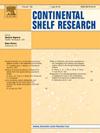On the interaction of mode-1 Internal Solitary Wave with higher modes to the west of northern Nicobar Islands
IF 2.2
3区 地球科学
Q2 OCEANOGRAPHY
引用次数: 0
Abstract
The synthetic aperture radar (SAR) image acquired on 23 April 2004 at 03:33 UTC by the Envisat shows the separation of short wavelength internal waves from the westward propagating mode-1 ISW generating from a shallow ridge connecting Batti Malv and Chowra Islands (SBM) of the northern Nicobar Islands, India. To investigate the presence of tailless mode-1 ISWs, several other SAR images near the SBM are analyzed. A particular SAR image captured on 12 October 2007 at 15:53 UTC reveals two different higher-mode ISWs in the path of the mode-1 ISW. Fitting the locations of the ISW signatures onto a time-distance curve shows that one of the higher modes is generated locally, while others are generated from SBM. Using simulations of a nonhydrostatic numerical model SUNTANS, we show that the SBM generated westward propagating mode-1 ISW overtakes the locally generated mode-3 ISW and a mode-2 ISW formed over the SBM in the previous tidal cycle. It is shown that the interaction process of the first mode with higher modes results in the formation of short internal waves trailing behind higher mode waves, pertaining to the resonance between the tail of mode-1 ISW and the higher mode solitary wave. Hence, close to a spring tide, with a combination of SAR images and numerical simulations, we show the dynamical process of westward propagating mode-1 ISW from SBM with the higher modes.
尼科巴群岛北部西部1型内孤立波与高模态的相互作用
由Envisat于2004年4月23日03:33 UTC获得的合成孔径雷达(SAR)图像显示,从印度北部尼科巴群岛连接巴蒂马尔夫群岛和乔拉群岛(SBM)的浅海脊向西传播的模式1 ISW产生的短波内波分离。为了研究无尾1型isw的存在,分析了SBM附近的其他几张SAR图像。2007年10月12日15时53分拍摄的SAR图像显示,在第一模式ISW的路径上有两个不同的高模式ISW。将ISW信号的位置拟合到时间-距离曲线上表明,其中一个较高的模态是本地产生的,而其他模态则是由SBM产生的。利用非流体静力数值模式SUNTANS的模拟,我们发现SBM产生的向西传播的1型ISW超过了局地产生的3型ISW和上一个潮汐旋回在SBM上形成的2型ISW。结果表明,第一阶模态与高阶模态的相互作用过程导致短内波尾随在高阶模态波后,这与1阶ISW的尾部与高阶模态孤立波之间的共振有关。因此,在接近一次大潮的情况下,结合SAR图像和数值模拟,我们展示了SBM向西传播高模态1型ISW的动力学过程。
本文章由计算机程序翻译,如有差异,请以英文原文为准。
求助全文
约1分钟内获得全文
求助全文
来源期刊

Continental Shelf Research
地学-海洋学
CiteScore
4.30
自引率
4.30%
发文量
136
审稿时长
6.1 months
期刊介绍:
Continental Shelf Research publishes articles dealing with the biological, chemical, geological and physical oceanography of the shallow marine environment, from coastal and estuarine waters out to the shelf break. The continental shelf is a critical environment within the land-ocean continuum, and many processes, functions and problems in the continental shelf are driven by terrestrial inputs transported through the rivers and estuaries to the coastal and continental shelf areas. Manuscripts that deal with these topics must make a clear link to the continental shelf. Examples of research areas include:
Physical sedimentology and geomorphology
Geochemistry of the coastal ocean (inorganic and organic)
Marine environment and anthropogenic effects
Interaction of physical dynamics with natural and manmade shoreline features
Benthic, phytoplankton and zooplankton ecology
Coastal water and sediment quality, and ecosystem health
Benthic-pelagic coupling (physical and biogeochemical)
Interactions between physical dynamics (waves, currents, mixing, etc.) and biogeochemical cycles
Estuarine, coastal and shelf sea modelling and process studies.
 求助内容:
求助内容: 应助结果提醒方式:
应助结果提醒方式:


